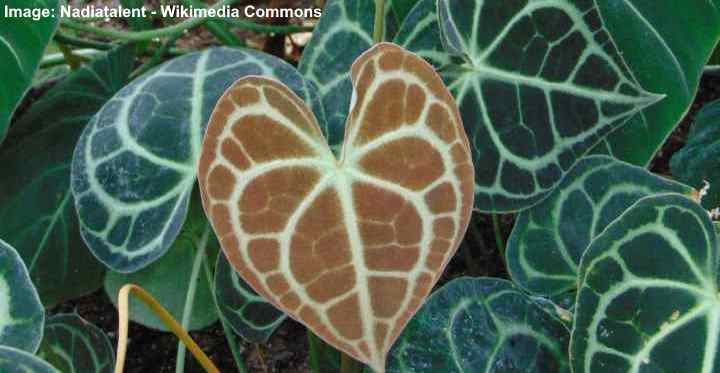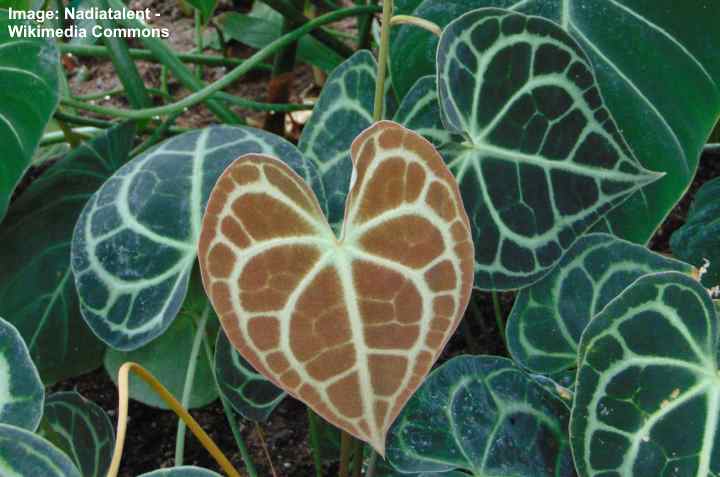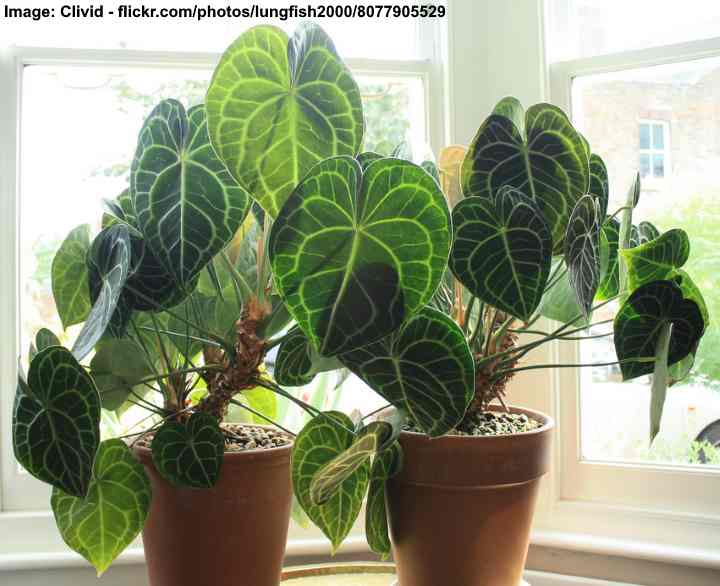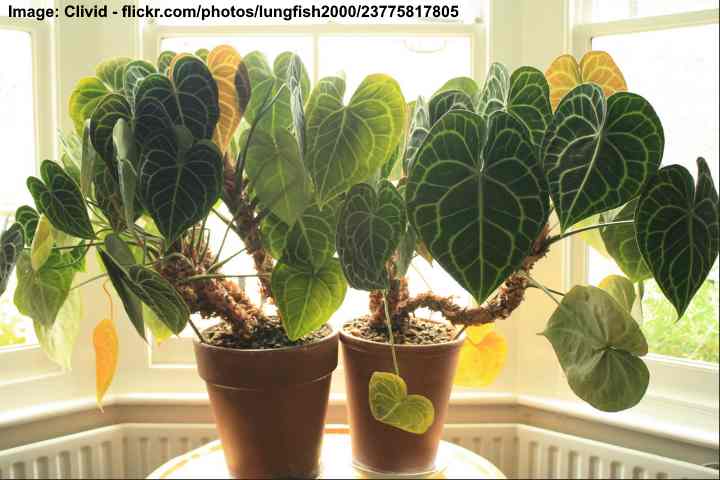Anthurium Clarinervium Care: How to Grow Velvet Cardboard Anthurium

The Anthurium clarinervium—also called the velvet cardboard anthurium—is a stunning tropical plant that thrives indoors. This anthurium species has huge dark green, leathery, heart-shaped leaves that feature prominent creamy-white veins. Other common names for this tropical houseplant include ‘Queen Anthurium’ and ‘White-Veined Anthurium’. The name ‘Velvet Cardboard Anthurium’ comes from its thick, velvety leaves.
How to care for velvet cardboard anthurium: The Anthurium clarinervium thrives in bright, filtered sunlight when it’s growing in moist soil with excellent drainage. Water anthuriums when the top 1” (2.5 cm) of soil is dry, keep humidity above 60% and fertilize every two months during the growing season. The ideal temperature is 65°F to 73°F (18°C – 23°C).
As an ornamental indoor plant, the anthurium clarinervium plant leaves grow to between 8” and 10” (20 – 25 cm). Most types of anthurium—including the clarinervium—have slow to moderate growth, and this species of plant grows to about 1 to 2 feet (30 – 60 cm). The velvet cardboard anthurium has a spread of up to 3 ft. (90 cm).
It’s important to mimic Anthurium clarinervium’s native tropical habitat of Mexico. Keeping temperatures warm, appropriate watering, and high humidity can help prevent many growing issues. For example, watering too often or direct sunlight can cause yellowing leaves. Or, a lack of water or direct sun can cause the tips of leaves to turn brown.
When it comes to blooming, the Anthurium clarinervium has inconspicuous flowers. Some species of anthurium houseplants are prized for their red waxy flowers that bloom all year long. The two most common examples is the flamingo lily – Anthurium andreanum or Anthurium scherzerianum – with shiny red spathes and colorful spadices.
Anthurium Clarinervium Care
The velvet cardboard anthurium isn’t fussy when it comes to growing indoors in pots. However, it has a few care requirements to thrive. If you meet its needs, the plant will grow for many years and produce spectacular patterned foliage.
Let’s look in more detail at how to care for your Anthurium clarinervium houseplant.
Anthurium Clarinervium Light Requirements

Anthurium Clarinervium has heart shaped leather-like leaves with attractive white veins
Place the Anthurium clarinervium in bright, indirect sunlight where the large attractive leaves get plenty of light. Although velvet cardboard anthuriums can grow in medium light, they don’t grow well in low light or direct sunlight. Filtered, dappled, or indirect sunlight is similar to their native environment—under the rainforest canopy.
Anthurium clarinervium plants are not plants that survive well in low to no light. You can tell if your velvet cardboard plant isn’t getting enough light by its foliage. The bright, creamy-white veins may start to lose their vibrancy. You may also notice that the plant’s growth slows down, or its stems become leggy.
Standing in direct sunlight for many hours can also be detrimental to your plant’s growth. Direct sunlight can burn the leaves and cause them to become paler or turn yellow. You may even notice that the plant starts to wilt and become stressed.
The best place to put an Anthurium clarinervium for healthy growth is on an east-facing windowsill. In a south- or west-facing room, keep the plant a few feet away from the window or have it behind sheer curtains. A great location for anthuriums is in a well-lit bathroom. The bright light and humid conditions make this an ideal shower plant.
You can grow Anthurium clarinervium plants outdoors in the summer. However, you should remember to place the plant pot in partial shade or dappled sunlight. Keeping the anthurium out of the sun’s rays will help the plant achieve optimal growth outside.
Best Soil for Growing Velvet Cardboard Anthurium
Most tropical houseplants—including Anthurium clarinervium—need well-draining soil to grow. The potting mix should hold just enough moisture to hydrate the roots between watering. But it shouldn’t be so heavy that it becomes soggy or waterlogged. An overly-damp potting medium causes root rot, fungal diseases, and, ultimately, the death of your beautiful foliage plant.
To maximize growth, grow velvet cardboard anthuriums in a mixture of potting soil, peat moss, and orchid bark or perlite. Organic matter helps to retain some moisture, and the perlite or orchid bark help aerate the growing medium. Other suitable ingredients to improve soil drainage are crushed charcoal, mulch, bark chips, or sphagnum moss.
The best way to know if the potting soil has good drainage is to observe how water flows through and how often you have to water your anthurium. For example, water should start draining from the pot’s drainage holes fairly quickly. Also, you may need to adjust the potting mix if you have to water too frequently or only every so often.
How to Water Anthurium Plants

To care properly for your anthurium clarinervium, make sure not to overwater it to prevent root rot
In the growing season, you may have to water your Anthurium clarinervium as often as once or twice a week. In the fall and winter, you need to water less often—maybe as little as every few weeks. The general rule for watering an anthurium is this—only water when the top 1” to 2” (2.5 – 5 cm) is dry.
Before watering a velvet cardboard anthurium, check the soil for dryness. Poke your finger about an inch into the soil. If the potting medium is dry, then your plant needs watering. If you detect some moisture, wait a few days before checking again. But, always let the soil be your guide for when to water.
Another top tip for watering your Anthurium clarinervium is to water less often and thoroughly. Giving the soil a deep drench ensures that the roots get properly hydrated. After soaking the soil, allow all the excess water to drain out before putting the plant back in its bright location.
Avoid the temptation to water your plant often and a little. This watering technique is ineffective for anthuriums because it doesn’t allow the roots to get hydrated. All that happens is that you create an overly damp environment at the soil surface. So, your plant could end up showing signs of underwatering but also get affected by fungus gnats and white soil mold.
Factors that affect how often to water your plant include:
- Climate—Houseplants need watering more often in warm, dry weather than in cold conditions.
- Season—Plants enter a period of dormancy in the late fall and winter and require less watering.
- Type of pot—Plastic pots retain moisture better than terracotta or clay ones. Anthuriums growing in unglazed clay pots need watering more often than ones in glazed or plastic containers.
Temperature Requirements for Anthurium Clarinervium
Growing indoors, Anthurium clarinervium plants thrive in average room temperatures. The ideal indoor temperatures are between 65°F and 73°F (18°C – 23°C). The velvet cardboard plant will grow in humid conditions up to 86°F (30°C). However, it doesn’t like the cold. So, make sure it doesn’t drop below 55°F (13°C).
If you live in USDA zones 9a to 11, you can grow these tropical plants in your yard. They should be planted in a partly shaded spot and in soil that drains well.
You can also take your anthurium plants outdoors if summer temperatures average at least 65°F (18°C). Just put your plant pot in a bright spot, but protected from direct sunlight. Bring your plant indoors when the nighttime temperatures start dropping below 60°F (15°C).
Anthurium Clarinervium Needs High Humidity

Anthurium Clarinervium requires high humidity and warmer temperatures to thrive
Native to tropical rainforests in Mexico and Central and South America, velvet cardboard anthuriums need to grow in humid conditions. Anthurium plants need at least 80 percent humidity to thrive. High humidity helps speed up growth and keeps vibrant the plant’s lush green foliage and white veins.
Getting humid conditions at home can be challenging. That is one reason why many plant owners keep their Anthurium clarinervium plant in a bright bathroom. There are a few ways to get humidity levels right for velvet cardboard anthuriums. Let’s look briefly at these:
- Misting—Spraying a fine mist of distilled or filtered water can increase humidity around your plant. Do this daily or every other day, depending on how dry the air is.
- Use a pebble tray—Sitting the plant pot on a tray of stones that is half-filled with water can create a humid environment. As the water evaporates from the tray, it humidifies the leaves.
- Location—If your bathroom is too dark for growing houseplants, group plants together to increase humidity.
- Room humidifier—If you have several tropical indoor plants, investing in a humidifier can help keep air moisture at proper levels for plants to thrive.
How to Fertilize Velvet Cardboard Anthurium for Healthy Growth
Anthurium clarinervium plants don’t require much feeding during the growing season. You should use a regular houseplant fertilizer, diluted to half strength. Feed your plant every two months from March through September just after watering it. During the fall and winter, don’t fertilize the plant.
To care well for your Anthurium clarinervium, remember that too much fertilizer is just as bad as overwatering. So never fertilize or water more than you have to.
A challenge with growing tropical plants indoors is to prevent a mineral salt buildup. When growing outdoors, this is rarely a problem with anthuriums. Your indoor plants can benefit from a soil flush every three months or so.
To flush the soil, run water through the soil for a few minutes. This process will rinse out excess salts from the soil and help keep your plant growing healthily.
Pruning Anthurium Clarinervium

You can prune your queen anthurium once in a while to boost its growth
Velvet cardboard anthurium plants can benefit from the occasional pruning. Snipping off leggy stems, or dead foliage can encourage healthy, vigorous growth. At the same time, pruning helps improve the plant’s appearance by removing dead, faded, or diseased foliage. Anthurium pruning also allows you to propagate these stunning plants.
The best time to prune back your Anthurium clarinervium is in spring—just before the growing season. Use sterilized pruning shears or a sharp knife to cut off leggy, straggly stems. Because Anthurium clarinervium flowers are not of any aesthetic value, you can snip off any flower stems that appear. This type of pruning helps concentrate growth in the spectacular foliage.
Velvet Cardboard Anthurium Propagation
The two best ways to propagate Anthurium clarinervium plants is by root division or stem cuttings. To grow new plants from root division, remove the plant from its container and carefully separate the roots into two or three sections. Plant each of the sections in a pot with appropriate potting soil.
To propagate by stem cuttings, cut a stem from new growth that is a few inches long. Place in a jar of water for a few weeks until 1-inch (2.5-cm) long roots appear. Transfer to a small pot with moist potting soil. Cover with a plastic bag to retain humidity and put it in a bright location. Keep the potting medium moist, but not soggy, until the new plant starts growing.
Repotting Anthurium Plants

You may need to repot your Anthurium clarinervium in a larger pot to encourage growth
You may need to repot an Anthurium clarinervium every two or three years. Being slow to medium growers, anthuriums don’t become root bound quickly. Repotting allows you to transfer the plant to a larger container to encourage growth. Also, you can check the health of the roots and refresh the potting mix.
How to repot an Anthurium clarinervium:
- Gently remove the plant and root ball from its container.
- Shake off any excess soil and untangle the roots as necessary.
- If you are dividing the plant, split off a few sections of the roots, making sure there are two or three healthy stems on each section.
- Half-fill a new pot with an appropriate a fresh, sterilized potting mix.
- Put the plant in the pot and fill the remaining space with the soil, ensuring that the plant is growing at the same height as before.
- Water it thoroughly and resume watering when the top part of the soil has dried out.
Is Anthurium Clarinervium Toxic?
Yes, all parts of velvet cardboard anthuriums are toxic to humans and animals. The plants contain insoluble calcium oxalates, which can cause severe ulceration if ingested. According to the American Society for the Prevention of Cruelty to Animals, plant species in the genus Anthurium are poisonous to cats, dogs, and horses. (1)
There are also medical reports that ingesting anthurium plants can cause oral irritation, swelling, and chest discomfort. So, keep the plants away from pets and children. (2)
Pests and Diseases Affecting Velvet Cardboard Anthurium
Houseplant pests such as aphids, spider mites, and mealybugs can infest anthurium plants. The plant’s need for high humidity makes it attractive to several pests. Humid conditions can also cause problems with fungal diseases and root rot. This is one reason why watering only as often as you need to is essential.
To keep your plants healthy, it’s important to know how to spot the signs of houseplant pests. Please read this article for top tips on getting rid of plant pests naturally.
FAQs on Growing Anthurium Clarinervium Plants Indoors
Why isn’t my anthurium clarinervium growing?
Adequate light and high humidity are essential for healthy anthurium plants to grow. Try moving your large-leafed plant to a brighter location, but out of direct sunlight. If necessary, increase humidity by misting daily or placing your plant pot on a humidifying pebble tray.
Why are my velvet cardboard anthurium leaves turning yellow?
Not getting enough filtered sunlight is often a reason why anthurium clarinervium leaves start turning yellow. You may also notice that the plant stems become droopy and look as if they are dying. If your anthurium plant is already growing in a bright location, the yellow leaves may be due to root rot. Try repotting your plant in fresh potting soil and trim off any diseased, mushy-looking roots.
Why do the leaves on my anthurium clarinervium have brown tips?
A lack of humidity is often the reason why the tips of velvet cardboard anthurium leaves become brown. First of all, make sure that you drench the soil every time it needs watering and allow it to partially dry before the next watering. Next, keep the air around the anthurium plant humid by regular misting or installing a humidifier.
Do velvet cardboard anthurium plants flower?
Anthurium clarinervium plants bloom, but their flowers differ from the types of anthurium that are usually sold in garden centers. Velvet cardboard plants have small, understated flowers. Anthurium clarinervium are grown for their spectacular, large heart-shaped leaves with brightly colored veins.
Related articles:
- 14 Anthurium Types (Including a Care Guide)
- How to Care for an Anthurium (Flamingo Flower or Flamingo Lily)
- The Best Shower Plants to Keep in Your Bathroom
